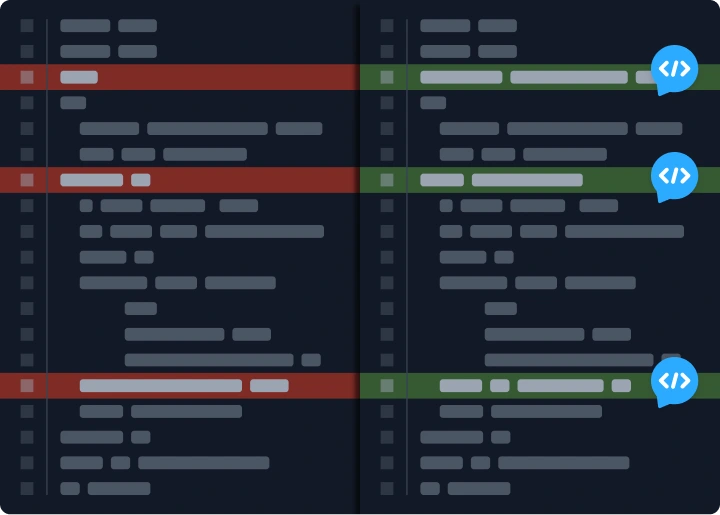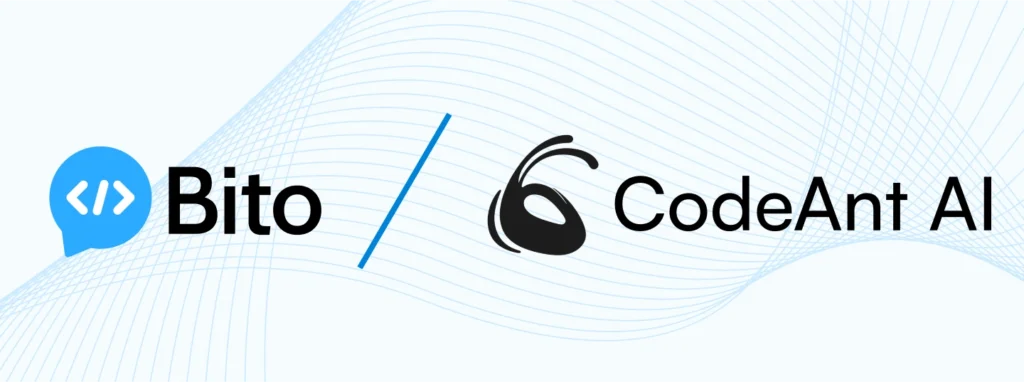Get high quality AI code reviews
- 90+ point analyses
- AI that understands your code
- Bito vs CodeAnt AI
Bito vs CodeAnt AI
Bito’s AI Code Review Agent and CodeAnt AI are both AI-powered code review tools that help developers and engineering teams by automatically analyzing code changes in pull requests. They act like diligent senior engineers – catching bugs, flagging security issues, and suggesting improvements – to speed up development cycles and improve code quality.
While both tools share the same goal of reducing the manual effort in code reviews, they differ in features and overall approach.
In this comparison, we’ll break down how Bito and CodeAnt stack up against each other so you can decide which AI code reviewer best fits your team’s needs.
Choosing the right AI code review tool
When evaluating modern AI code review tools, teams typically look for a solution that integrates smoothly into their workflow and enhances productivity without creating noise. Key factors to consider include:
- Contextual understanding: The AI should grasp the broader context of your codebase, not just review changes in isolation. This reduces false positives and ensures feedback is relevant.
- Integration capabilities: Seamless integration with your version control platforms (e.g. GitHub, GitLab, Bitbucket, etc.) and development environment is crucial so that the AI becomes a natural part of your existing code review process.
- Customization: The ability to tailor the tool’s behavior to your team’s coding standards and conventions is important. Teams should be able to enforce custom rules or style guides so the AI’s feedback aligns with their best practices.
- Security and compliance: It’s essential that the tool meets enterprise security requirements (encryption, data privacy) and complies with standards, especially since it will access your code. Support for on-premises deployment can be a plus for organizations with strict data policies.
- User experience: A good AI code reviewer provides clear, actionable insights without overwhelming developers. The interface (whether in the IDE, CLI, or pull request comments) should be easy to use and the AI’s suggestions should be understandable and helpful.
With these criteria in mind, let’s examine how Bito’s AI Code Review Agent compares to CodeAnt AI on the factors that matter most.
Key differentiators of Bito’s AI Code Review Agent

Unlike CodeAnt, which offers a more traditional static-analysis-heavy approach, Bito’s AI Code Review Agent brings a number of unique strengths to the table. Here are five key areas where Bito stands out:
1. Context-aware code reviews
Bito delivers highly context-aware code reviews by understanding your code changes in the context of the entire codebase. It goes beyond simple pattern matching and employs advanced techniques (like building abstract syntax trees, indexing symbols across your repository, and using semantic embeddings) to grasp how a change relates to the rest of the project. This deep codebase awareness means Bito’s feedback is more precise and less likely to miss critical issues. Developers receive insights that consider how the new code interacts with existing modules, usages of functions, and overall architecture.
This level of context sensitivity helps Bito catch subtle bugs and side effects that might slip through tools that only analyze diffs superficially. While CodeAnt does perform thorough static analysis and scanning, Bito’s richer understanding of code semantics ensures a more intelligent review. In practice, Bito acts as if it “knows” your codebase, leading to feedback that feels closer to what a human reviewer familiar with the project would provide.
2. Multiple specialized engineers for targeted code analysis
Bito’s AI Code Review Agent can operate like multiple specialized engineers focusing on different aspects of your code. It offers commands and modes that let you target specific concerns – for example, you can ask Bito to /review security or /review performance to get a focused analysis on those areas. Under the hood, Bito combines general AI analysis with a suite of specialized tools (linters, static analyzers, vulnerability scanners, etc.), each acting as an expert on a particular domain (security, performance, scalability, style, and so on). The result is a comprehensive review where each category of issue is examined with expert-level depth.
This targeted analysis capability means you can zero in on what matters most for a given pull request. If you’re particularly concerned about security in one PR, Bito will behave like a security expert; if another change is performance-critical, Bito can act as a performance guru. In contrast, CodeAnt runs a broad set of checks on each pull request but doesn’t allow on-the-fly specialization for a particular focus area. Bito’s approach ensures that the feedback is not only thorough but also relevant and focused, addressing the unique needs of each review with specialist-level insights.
3. Incremental code reviews
Bito is designed for continuous and incremental code reviews, meaning it keeps pace with your pull request as it evolves. Every time new commits are added to a PR, Bito automatically re-reviews the changes and updates its feedback. Crucially, it does this intelligently – tracking what has already been addressed and focusing on the net new changes – so developers aren’t bombarded with duplicate comments or stale issues that were fixed in a previous commit. This incremental approach is like having a vigilant reviewer who watches every update in real time and only speaks up about the latest relevant concerns.
For fast-moving teams, this saves a lot of time. Developers get immediate verification that their follow-up commits resolved the earlier issues, and they can catch any new problems introduced along the way. CodeAnt AI, on the other hand, typically provides a one-time review for each push or pull request. It lacks Bito’s dynamic incremental review mechanism that continuously refines feedback as the code changes. Bito’s ability to do ongoing reviews ensures that the code review stays up-to-date and that no new bug slips in late in the development cycle – something especially valuable in large features or long-running branches where code is pushed frequently.
4. Chat with the AI Code Review Agent
One of Bito’s most developer-friendly features is the ability to chat with the AI Code Review Agent. After Bito reviews your code, you can ask the AI follow-up questions or request further explanations right in your workflow. Developers can query “Why is this a bug?” or “Show me an example fix for this issue” and get immediate, interactive responses from Bito. This turns code review into a two-way conversation and learning experience. Instead of just receiving a list of comments, you can dive deeper into any feedback point until you fully understand it or have a plan to address it.
This real-time dialogue dramatically accelerates the review process. Unclear suggestions or complex issues can be clarified on the spot, without waiting for a human reviewer’s schedule. It’s like having the reviewer sitting next to you, ready to explain their reasoning. CodeAnt AI does not offer a built-in interactive chat for discussing review results in this way, making Bito’s conversational interface a significant advantage. By chatting with Bito’s agent, engineering teams can resolve doubts immediately and implement fixes faster, reducing the back-and-forth that often slows down code reviews.
5. Custom code review rules and guidelines
Every development team has its own standards and best practices, and Bito’s AI Code Review Agent is built to accommodate that through custom code review rules and guidelines. Teams can easily configure Bito to enforce their specific coding conventions or architectural guidelines. Whether it’s a naming convention, a particular error-handling pattern to avoid, or performance best practices unique to your domain, you can teach those to Bito. The AI will then check pull requests against these custom rules and flag any violations, just like a human reviewer intimately familiar with your guidelines would do.
Moreover, Bito continuously learns from your feedback. If you dismiss certain suggestions or consistently accept others, Bito adapts its outputs over time to better match your preferences. This feedback loop helps reduce noise and tune the agent to what your team cares about. While CodeAnt also allows adding custom policies to its rule set, Bito makes this process especially seamless and intelligent. Defining new rules or guidelines in Bito is straightforward (often as simple as providing example patterns or brief instructions), and the AI’s ability to refine its reviews based on developer interactions is more advanced. The result is an AI code reviewer that can be personalized to your team’s needs, ensuring that the advice it gives is aligned with what you consider high-quality code.
Side-by-side comparison

To provide a clear overview, below is a side-by-side comparison of Bito’s AI Code Review Agent and CodeAnt AI across various dimensions. Each table focuses on a different aspect of the tools, from core code review capabilities to security features, performance metrics, and more.
1. Code review quality
| In-depth codebase understanding |
Supported languages Learn more |
|
| General code review |
Supported languages |
|
| Integrated feedback from specialized dev tools (such as static analyzers, linters, secret scanners, and open source vulnerability checkers) | ||
| Custom code review rules |
2. Feature comparison
| Chat-based interaction | ||
| Integration with multiple Git providers (such as GitHub, GitLab, or Bitbucket) |
GitHub, GitLab, Bitbucket, GitHub (Self-Managed), and GitLab (Self-Managed) |
GitHub, GitLab, Bitbucket, and Azure DevOps |
| Pull request summary | ||
| High-level feedback | ||
| Review effort estimation |
Learn more |
|
| Continuous/incremental reviews | ||
| Inline suggestions with one-click to accept suggestions | ||
| Automated and manually triggered AI code reviews | ||
| Code review analytics | ||
| Comprehensive language support |
3. Code analysis
| Real-time code analysis using AI | ||
| Static code analysis | ||
| Open-source security vulnerabilities check | ||
| Secrets scanner (e.g., passwords, API keys, sensitive information) |
4. Security and compliance
| SOC 2 Type II compliance | ||
| Code is never stored, retained, or used for model training purposes | ||
| On-premises deployment |
5. Customization features
| Custom code review rules | ||
| Include/exclude files, folders, or Git branches from AI code reviews | ||
| Feedback mechanism for AI suggestions | ||
| Targeted analysis of specific aspects of code (such as security, performance, etc.) |
Learn more |
6. Performance metrics
| PR merge acceleration | 89% faster | |
| Reduction in regressions | 34% fewer | |
| ROI per dollar spent | $14 |
7. Pricing
| Free plan available | ||
| Pro plan | $15 per user per month (billed monthly) | $12 per user per month (billed monthly) |
| Enterprise plan | $25 per user per month | Custom pricing (contact sales) |
8. Support and documentation
| Comprehensive documentation | ||
| Community support channels (such as Slack) | ||
| Dedicated support for enterprises |
9. Deployment options
| Cloud-based | ||
| On-premises |
Conclusion
Both Bito’s AI Code Review Agent and CodeAnt AI are powerful tools that can automate code reviews and help teams ship higher-quality code faster. They each offer core capabilities like multi-language support, security scanning, and integration into Git workflows to catch bugs and issues early. However, Bito distinguishes itself in several key ways that can be decisive for engineering teams. Bito provides a more interactive and context-aware experience – with its chat-based review discussions, deeper understanding of your entire codebase, and the ability to conduct incremental reviews as code changes. It also offers greater flexibility through custom rules and targeted analysis modes, allowing teams to tailor the AI to their specific needs and focus areas.
In practice, teams that choose Bito benefit from an AI reviewer that feels like an integral part of the team’s workflow and knowledge base. Bito’s agent can act as multiple specialized reviewers in one, giving nuanced feedback on security, performance, style, and more, all while adapting to your coding standards.
Bito enables faster pull request turnarounds, more consistent code quality, and ultimately greater confidence in every merge – helping your team move quickly without sacrificing quality or security.
